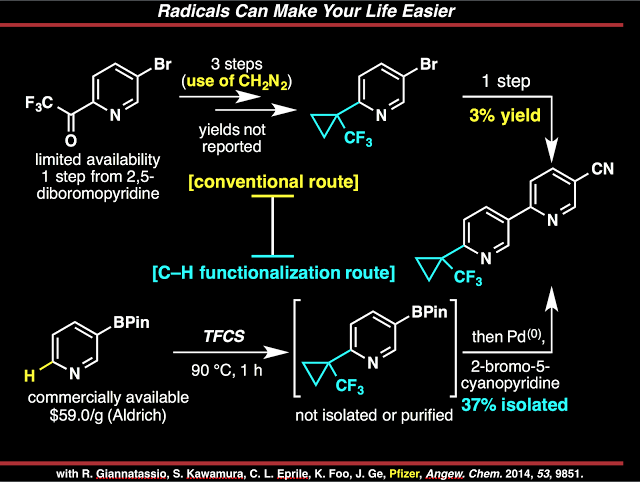Electrochemistry
Sulfinates can be easily prepared, even really exotic ones. Their reactions are not chaotic as people used to associate with radical chemistry – they are actually quite predictable as we showed in collaboration with the Blackmond lab. If there are process chemists interested in this chemistry, it can even be scaled up using electrochemistry.
As we had hoped, the main consumers of sulfinates are those residing in pharma as shown on the graph below, kindly provided to us by Aldrich.
The feedback we have gotten is that people really like the simplicity of the reaction setup and the ease with which the diversity of their scaffolds can be effortlessly expanded. This chemistry saves people a lot of time and can sometimes deliver analogs that would never have been made due to time constraints. A typical example is shown here:

They prepared this nice Brochure and sometimes even run humorous ads in C&E news like this one:
We hope the pharma community can continue to benefit from the robustness and unique chemoselectivity of this radical chemistry.
- 10.2 Nernst Equation
Electrochemistry : 10.2 Nernst Equation NERNST EQUATION Cell potential (E°cell) under any condition Ecell = E°cell – (RT/nF) ln Q R: universal gas constant. Q...
- Standard Hydrogen Potential
Standard Reduction PotentialsStandard reduction potential (E0) is the voltage associated with a reduction reaction at an electrode when all solutes are 1 M and all gases are at 1 atm. Standard hydrogen electrode (SHE) Reduction Reaction ...
- Galvanic Cell
Oxidation is defined as the addition of oxygen to a substancethe loss of hydrogen from a substancethe...
- Electrochemistry : 10.2 Nernst Equation
NERNST EQUATION Cell potential (E°cell) under any condition Ecell = E°cell – (RT/nF) ln Q R: universal gas constant. Q...
- Thermochemistry : 9.3 Born-haber Cycle
First Ionization Energy (IE1)Energy required for 1 mol of gaseous atom to lose 1 mol of electrons. Affinity Electron (EA) Energy change that occurs when 1 mol of gaseous atom gains 1 mol of electrons. Lattice EnergyEnergy change when 1 mol of solid...
Electrochemistry
Diversinate Update
Since our first report in 2011 on the trifluoromethylation of heterocycles, sulfinate chemistry has been demonstrated to be a useful tool for drug discovery. The lab extended this chemistry beyond trifluoromethyl radicals to a whole host of other useful substituents that medicinal chemists find desirable. We even went as far as to show that one could functionalize caffeine in its native habitat: oolong tea! Sulfinates have a wide range of useful applications: They can be used to forge heteroarylether bioisosteres, to label and tag compounds that have no obvious sites for functionalization ("native chemical tagging"), accomplish practical direct methylation without the misery of purification that other methods face, and even empower medicinal chemists to predict non-cytochrome based metabolism processes (we've received an enormous amount of positive feedback from companies on this).
Sulfinates can be easily prepared, even really exotic ones. Their reactions are not chaotic as people used to associate with radical chemistry – they are actually quite predictable as we showed in collaboration with the Blackmond lab. If there are process chemists interested in this chemistry, it can even be scaled up using electrochemistry.
As we had hoped, the main consumers of sulfinates are those residing in pharma as shown on the graph below, kindly provided to us by Aldrich.
 |
| Sulfinates Sell to the Customers They were Designed For |
The feedback we have gotten is that people really like the simplicity of the reaction setup and the ease with which the diversity of their scaffolds can be effortlessly expanded. This chemistry saves people a lot of time and can sometimes deliver analogs that would never have been made due to time constraints. A typical example is shown here:

Aldrich is planning on rolling out a number of new sulfinates (now marketed as "Diversinates") and they even sell a number of the reagents in a pre-made kit allowing medicinal chemists to easily automate lead diversification.
They prepared this nice Brochure and sometimes even run humorous ads in C&E news like this one:
 |
| A Humorous Ad |
We hope the pharma community can continue to benefit from the robustness and unique chemoselectivity of this radical chemistry.
- 10.2 Nernst Equation
Electrochemistry : 10.2 Nernst Equation NERNST EQUATION Cell potential (E°cell) under any condition Ecell = E°cell – (RT/nF) ln Q R: universal gas constant. Q...
- Standard Hydrogen Potential
Standard Reduction PotentialsStandard reduction potential (E0) is the voltage associated with a reduction reaction at an electrode when all solutes are 1 M and all gases are at 1 atm. Standard hydrogen electrode (SHE) Reduction Reaction ...
- Galvanic Cell
Oxidation is defined as the addition of oxygen to a substancethe loss of hydrogen from a substancethe...
- Electrochemistry : 10.2 Nernst Equation
NERNST EQUATION Cell potential (E°cell) under any condition Ecell = E°cell – (RT/nF) ln Q R: universal gas constant. Q...
- Thermochemistry : 9.3 Born-haber Cycle
First Ionization Energy (IE1)Energy required for 1 mol of gaseous atom to lose 1 mol of electrons. Affinity Electron (EA) Energy change that occurs when 1 mol of gaseous atom gains 1 mol of electrons. Lattice EnergyEnergy change when 1 mol of solid...
